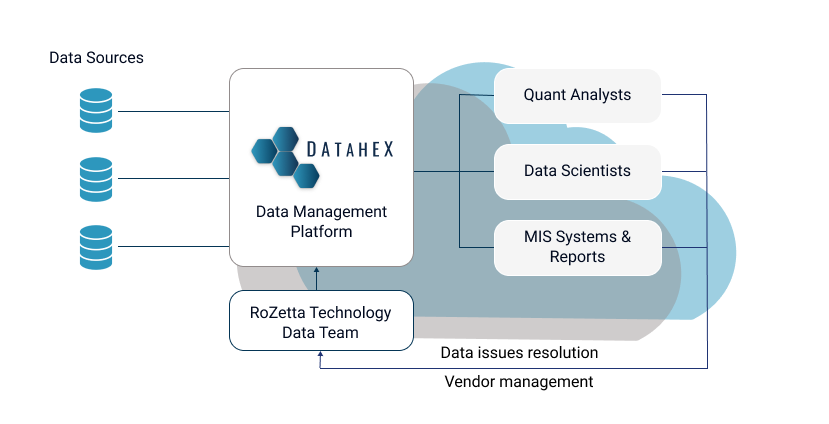How an Enterprise centric approach to data drives productivity
Read the article below or download the PDF version here.
Background
In complex markets, managing data is increasingly a differentiator in growing and maintaining revenues and profit margins. Particularly where third-party data is critical in identifying opportunities and threats to the price of any asset or the frequency of its purchase.
In capital markets, detecting early indicators of a change in value is directly related to effectively managing the growing volume and complexity of data used in decision-making models and workflow. Historical trading data is big and cumbersome and integrating it with an increasing range of alternate and ESG is complicated and resource intensive. Added to this is the expansion in compliance reporting required by a range of statutory authorities.
Optimizing the total cost of data ownership and stewardship is achievable if the organization adopts an Enterprise Centric approach to data management.
With the scarcity of talent and the need to develop new data and systems architecture to manage this expanding data universe, many organizations realize this is a non-core function.
This article explores the benefits of moving to an Enterprise Centric platform to drive productivity and moderate the total cost of data management instead of the less efficient User Centric model.
Overview
An Enterprise Centric platform, as opposed to User Centric, optimizes productivity and speed to decisions by presenting the best possible data to every end user in a format that is consumption ready, whether for developing trading models, discovery analytics, or reporting. Because remediation of all data enhancements and data quality issues are in the platform, the organization develops a unique data asset tuned to their specific needs. This can lead to achieving a competitive advantage through data.

User-centric model
The data flow in a User Centric Model can seem a bit like a bowl of spaghetti, making it hard to manage compliance and licensing costs. Acquisition of source data by varying organizational levels and roles, often multiple times, with end users doing much of the data clean-up and integration. It is a very task driven model.
An Enterprise Centric model is characterized by clear lines of accountability for acquisition, storage, normalization, completeness, quality, and data access. In an Enterprise Centric solution, various software tools and APIs can access the data, and the platform partner manages vendor issues.
The alignment of responsibilities with expertise is a real productivity gain. Data Scientists and Quantitative Analysts get on with identifying and executing value creation free of the tasks of repeatedly wrestling the input data into a format ready for consumption.
Market Dynamics
RoZetta Technology's DataHex platform is a response to powerful, transformative forces that have changed data management in data intensive industries:
- Powerful and efficient cloud computing
- The demand to integrate data science capability
- Scalable platform as a service
- The explosion of new sources of data.
Significant investment in cloud infrastructure, new analytics, and new data sources demand a platform to bring them together. There is a clear need for proven solutions to manage complex time series data across asset classes and then organize, enhance and integrate to empower all users with analytics-ready data.
Delivering analytics-ready, consumption-ready data is key to optimizing value creation by supporting a data-driven decision-making culture.
Bespoke legacy systems create data bottlenecks while market participants upgrade to current data and technology platforms to ensure they remain competitive.
RoZetta’s DataHex provides an Enterprise Centric Platform as a SaaS scalable, purpose-built, cloud-managed service to meet the specialized needs of all users across an enterprise. It is a proven platform that de-risks and eliminates bottlenecks in managing large-scale time series data. It also delivers streamlined data access via a search engine, data mapping, API connectivity, and cloud delivery.
DataHex drivers of value
Productivity gains
Data and technology agnostic connectivity
- DataHex aligns data accountability to roles with the right expertise – builds productivity. The result is every user shares the benefits of higher data quality - the focus becomes value generation.
- Fixing the data issues at the platform level means fixing issues once for all users.
- The platform partner replaces any distraction caused by data vendor issues - the focus here is to get the best value from vendors.
- RoZetta’s DataHex is data vendor agnostic and has ingestion processes for the major data vendors and delivery capability to multiple cloud platforms.
- Data can be accessed using an intuitive user interface, a suite of APIs, or scheduled extract routines.
- While DataHex’s native environment is AWS, DataHex can deliver data extracts to any preferred technology or distribution channel.
Data quality enhancements
Data curation analytics ready data
- Many data quality issues, like data gaps, can be resolved by actively managing data vendors.
- Security Master and reference databases are validated and updated as part of the data ingestion process.
- RoZetta also provides standard market metrics as options, like 1-minute, 5-minute, and End-of-Day time bars.
- Clients can specify customized market metrics and time bars to ensure consistency with existing logic used in analysis and modeling.
- RoZetta fuses data engineering and data science to develop sophisticated algorithms that drive ingestion, validation, transformation, normalization, indexing, and optimized interrogation speeds.
- RoZetta can configure bespoke business rules for data ingestion and loading routines to minimize any risk of transition from any existing platform.
- Data ingestion allows for data normalization rules for the configuration of exchange-specific rules.
How much value?
Client feedback demonstrates that data operations costs are reduced by >50%, as DataHex does much of the bulk of the data preparation and validation for end users.
Additional operation costs are saved by managing data vendors and actively managing data licensing and compliance requirements.
The productivity gain is realised by transferring data preparation from high-cost analysts and data scientists to a proven specialist system that improves the data for everyone's benefit. Time saved by quantitative analysts and data scientists is redirected to the core responsibility, value creation.
Summary
This table highlights the difference between a User Centric and Enterprise Centric data management approach.
User Centric
The productivity impact of data islands
Enterprise Centric
Productivity increases by socializing benefits
Multiple sources of data
- Inconsistent & incomplete history
- Data quality issues fixed at the task level
- Minimal sharing of data improvements & enhancements
- Data supplied in vendor format
- Every task has some level of data 'wrangling'
- Data operations fix issues
- Data operations tasks move to the user, data wrangling
- Many points of contact for data vendor issues
- Data availability tied to resource availability
- Same data stored many times
- Data not indexed for optimized access and storage
- Inconsistent model outcomes as treatment of data are inconsistent
Single source of facts
- License data once
- Consistent & complete history
- Data quality issues fixed for all users
- Optimized storage and compute
- Current and historical symbology mapping across all source files
- Multiple entity identifiers enable easier testing & integration of alternate data
- Access via GUI and APIs
- Catalog function for discovery
- Data delivered analytics ready
- The technology of choice i.e. multiple cloud platforms, Snowflake, Azure, Big Query, AWS S3 etc...
- Automated scheduled extracts
- Flexible file formats and field order
- Data enhancements benefit all users
- Single point of contact for data vendor issues.
Contact RoZetta and take the productivity challenge
RoZetta has developed a model that estimates the value of moving to our cloud-based Enterprise Centric model of data management. With very few inputs, like head counts for data operations and analytical resources and the average cost for each role, RoZetta can provide an estimate of the financial gain based on moderating operational costs and increasing revenue opportunities for your organization.
Contact RoZetta and take up the challenge today.
